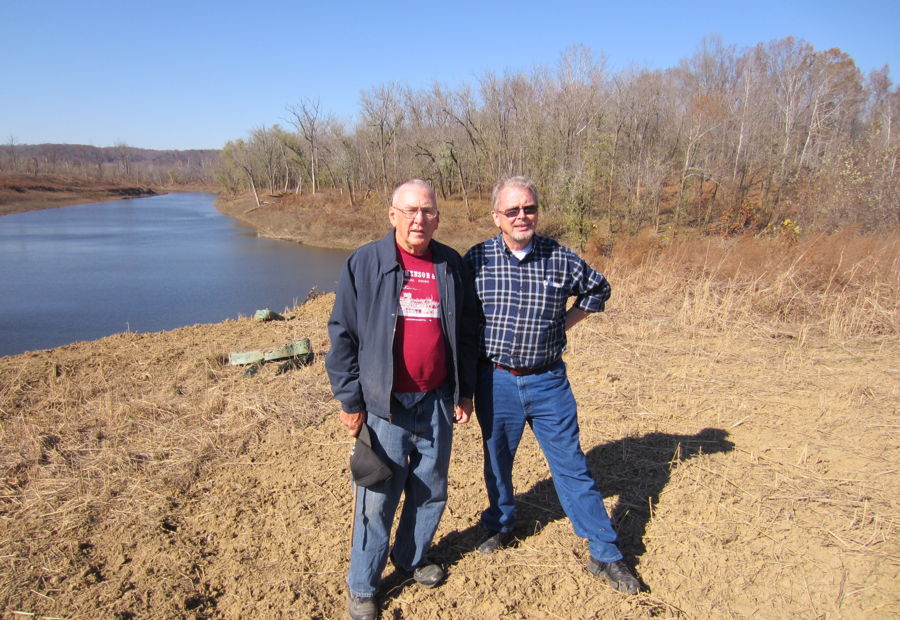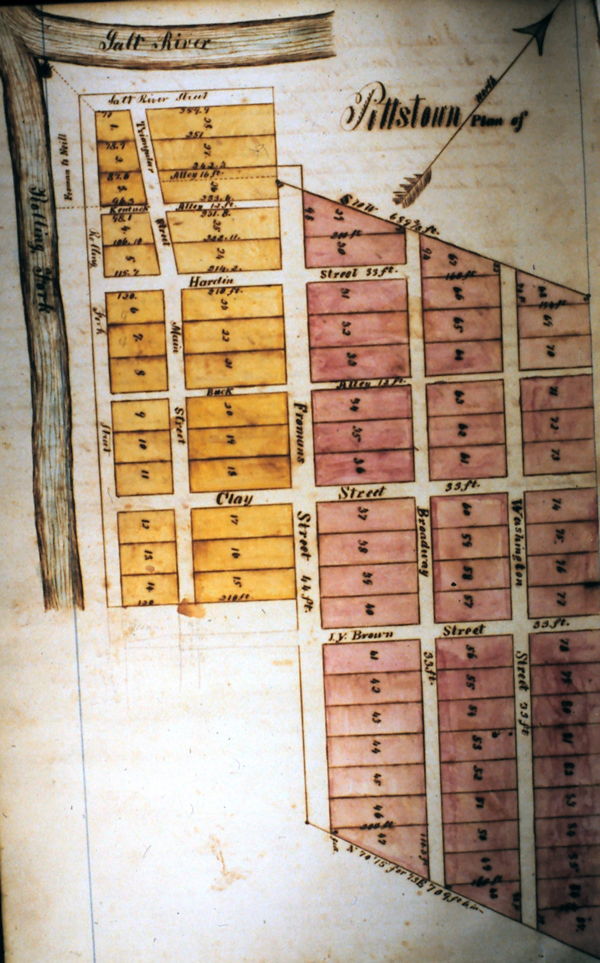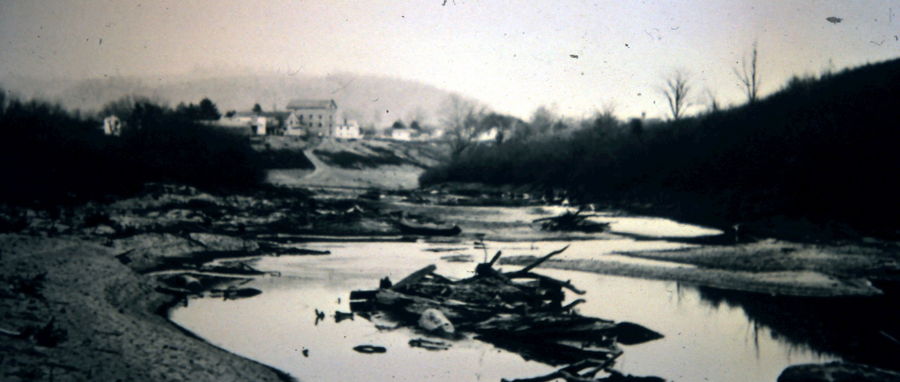
The following article by David Strange originally appeared in The Courier-Journal on 11 Dec 2013. It is archived here with additional information for your reading enjoyment.
There is much to be said about the town of Pitts Point, which once thrived, survived, and died, in Bullitt County. Certainly there is far more than this poor writer can say in this column. Author and historian, Gary Kempf, provided many pages about the town in his extensive compilation, A History of Fort Knox, published by the Ancestral Trails Historical Society in 2004. West Point historian, Richard Briggs, has also done much research and writing on the subject, as have a few others.

But let me tell you now, just a little about a town that once was, but is no more. A town of which I hope to occasionally write more over the coming months.
Pitts Point, first known as Pittstown, was located on the western edge of Bullitt County, in the juncture of the Rolling Fork and the Salt Rivers. I think most historians would agree that this "point" on the river was a natural stopping place, probably used by Native Americans long before others came along. Rivers were once the highways of transportation. From Pitts Point, a boat could easily go downstream about eight miles or so to the great Ohio River, and from there follow the rivers and streams for thousands of miles. From Pitts Point upstream, it was a little more difficult. Except in flood season, boats any larger than canoes or small flatboats could seldom travel much further up the Salt River or up Floyds Fork.
So Pitts Point was a natural stopping off point, especially with the coming of steam boats. Pioneers would haul their products from miles around, across land or in smaller boats downstream to Pitts Point, where it would be loaded on large boats and transported on to other destinations for sale. And in turn, the large boats would come up stream to Pitts Point, land on its gentle shoreline, and sell finished goods to the farmers and towns people. If you look at old road maps of the area during the thriving times of Pitts Point, you will see many roads heading straight to the town. Salt from the pioneer salt furnaces was brought; iron from the Belmont Iron Furnace; iron stoves from Shepherdsville headed to Shakertown; lumber and grain livestock from all around the area headed as far away as New Orleans.
For many years Pitts Point was the hub of transportation for much of the Bullitt County area.

The closest thing to an official beginning of Pitts Point was probably August, 1831, when Abraham & Hanna Froman, who were operating a ferry there at the time and whose family had claim to the land at least as far back as 1798, sold 600 acres to James G. Pitts and John S. Pitts. These Pitts brothers laid out part of the land into 87 lots, started selling them, and soon there was a bustling little community.
A post office was established in 1842. The first public school was formed around 1850. This was the height of the great steam-powered river boats. Literally hundreds of the grand old paddle-wheelers plied the Ohio River, and many would include a stop at West Point, and then head on up the Salt River to Pitts Point. The Civil War caused much trouble from 1861 to 1864, but just after that, things seemed to go well for the town again. A Masonic Lodge, Butler #194, was formed in 1867. A new "Pitts Point Academy" secondary school was incorporated in 1870 and drew much praise for its quality of higher learning.
The rich farmland in the area, along with the nearby river transportation, allowed farms to prosper and products to be easily sold. A large, multistory, steam-powered, flour mill was built in town by J.V. Froman.
The population of the town was 300 in 1860, but that was the peak. I wonder if the residents realized it then, but the growth of railroads was already spelling doom for the little town that was so dependent on river traffic. The L& N Railroad was built in 1855, and railroads in general soon became major competition for river transportation. Railroads were relatively reliable year-round; river transportation was often hindered by winter ice, spring flooding, or summer drought. In addition, for Pitts Point, the little river town was susceptible to frequent flooding.

By 1887, the town population dropped by half, to 150. In 1897, a telephone line was run to the town (the original old telephone exchange is on display at the Bullitt County History Museum), but the writing was already on the wall. There was talk in 1902 and 1903 about building locks and dams along both the Salt River and the Rolling Fork, upstream from Pitts Point, to enhance river traffic, but nothing ever came of it. By 1939, the town was almost a ghost town. Churches and other buildings were in disrepair and some no longer used at all.
By the time the town of Pitts Point was purchased by the federal government to expand Fort Knox in 1942, there were only about a dozen resident owners remaining.
World War II created the need for expanded artillery and tank training, and this area was chosen to fill that need. The government bought out the town and surrounding farms. Pitts Point, along with farms, homes, churches, schools, and cemeteries that had ties to the same families for generations, ceased to be. Some people left willingly; many did not, creating bitter feelings in some families that last to this day.
Home movie from Momen (Jug) Quiggins in 1956. Richard Briggs, local historian, made a trip up Salt River from West Point, KY, with Jug Quiggins. They explored Pitts Point after it was purchased by the government as part of the Fort Knox military reservation. It had been vacant for many years at this time. This video comes from YouTube.
The area where the town once stood is unrecognizable as such today. Much of the area became an artillery range. The buildings were damaged, destroyed, and the remains eventually burned in a brush fire. The shores of the town itself have been used for military beach-landing exercises, and the grounds much churned up by heavy equipment. Only the most knowledgeable person could find any sign that there had once been a thriving little town where only trees and brush thrive today.
There is a new display in the Bullitt County History Museum, which displays the old school bell from Pitts Point Academy, and the phone operator's exchange from the town. An old radio hauntingly plays vintage, static-filled radio reports about the December 7, 1941 invasion of Pearl Harbor, which started WWII, and in a way marked the end of a fading town called Pitts Point.
Only memories and a few blurry photographs now remain of a once-thriving little Bullitt County town that is no more.
A little river town named Pitts Point.
Copyright 2013 by David Strange, Shepherdsville KY. All rights are reserved. No part of the content of this page may be included in any format in any place without the written permission of the copyright holder.
The Bullitt County History Museum, a service of the Bullitt County Genealogical Society, is located in the county courthouse at 300 South Buckman Street (Highway 61) in Shepherdsville, Kentucky. The museum, along with its research room, is open 10 a.m. to 4 p.m. Monday through Friday. Saturday appointments are available by calling 502-921-0161 during our regular weekday hours. Admission is free. The museum, as part of the Bullitt County Genealogical Society, is a 501(c)3 tax exempt organization and is classified as a 509(a)2 public charity. Contributions and bequests are deductible under section 2055, 2106, or 2522 of the Internal Revenue Code. Page last modified: 12 Sep 2024 . Page URL: bullittcountyhistory.org/memories/pittspt1.html